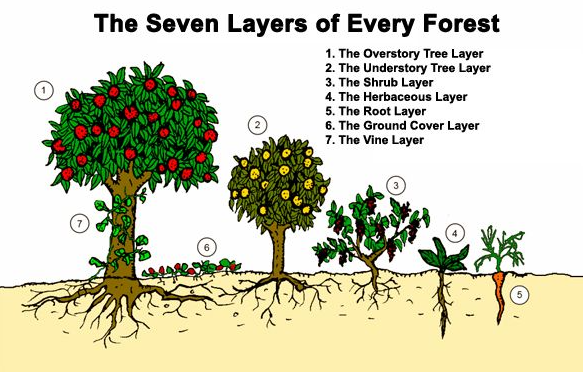“Forests are ecosystems with a diversity of plants, animals, and fungi. They were designed by nature to have perfect balance. A food forest is a version of this in which the different, balanced components produce food. When we understand how nature creates its ecosystem, we can model that with productive species to produce food sustainably, with minimum inputs for maximum outputs.” Geoff Lawton (from the DiscoverPermaculture.com website)
A food forest, also called a forest garden, is a diverse planting of edible plants that attempts to mimic the ecosystems and patterns found in nature.
A food forest mimics the diversity of a natural forest where a variety of plants grow together as an ecosystem. By modelling this concept in the garden, plants grouped together complement each other, take advantage of niches and microclimates, increase biodiversity and ensure healthy soil and plants, as well as looking beautiful, and providing food to humans.
A Food Forest is specially designed to emulate a real forest and work with, and benefit, nature. The difference is that our design means that we can adapt it to have the food plants and trees that we want.

Forests layers
In theory a “forest garden” (aka “food forest”) has seven layers:
Canopy layer (large fruit trees),
Understorey (smaller nut and fruit trees),
Shrubs (berries and large perennials),
Herbaceous (herbs and plants),
Rhizosphere (root crops),
Groundcover (clover and strawberries)
Vines (climbing beans, peas etc.).
Some also like to recognize the mycelial layer, layer eight (mushrooms).
Designing a Food Forest
In designing a food forest, we use those layers to fit more plants in an area without causing failure due to competition and to ensure the design works for our benefit.
The system remains very stable when all the layers are occupied BUT you don’t have to have all seven layers for the plants to benefit from each other.
A food forest my not necessarily have all seven layers, but it does need to have multiple layers to ensure it is a virtually self-sustaining living ecosystem.
Benefits of Forest Gardens
In designing a forest garden/ food forest, we use those layers to fit more plants in an area without causing failure due to competition and to ensure the design works for our benefit.
The system remains very stable when all the layers are occupied BUT you don’t have to have all seven layers for the plants to benefit from each other.
A food forest my not necessarily have all seven layers, but it does need to have multiple layers to ensure it is a virtually self-sustaining living ecosystem.
Forest garden design can have numerous benefits, particularly to reduce the need for human input, making them a low maintenance, resilient way of growing food. Such benefits of food forest design, include:
- giving emphasis to perennials and self-seeding annuals to prevent the need for re-planting year after year
- designing for placement of plants to create micro-climates and windbreaks
- suppressing growth of weeds by planting thickly and using ground covers
- preventing water evaporation and encouraging water retention through mulching and different ground-shaping techniques
- creating healthy soil through using permaculture techniques such as “chop & drop”, “no dig”, use of natural plant fertilisers, and employing nitrogen-fixing and nutrient-accumulating plants to return waste to the land
- keeping pest populations to a minimum and from causing damage by planting a diverse array of plants that attract beneficial pollinating insects and natural predators to manage them

